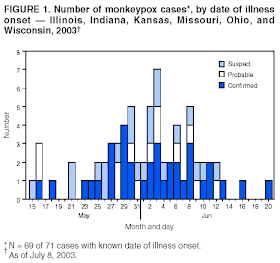Monkeypox in Africa.
Monkeypox has
presumably occurred in sub-Saharan Africa for thousands of years, ever
since humans acquired the virus through
direct contact with infected animals. There are data to suggest that
monkeys
are, similar to humans, incidental hosts, and that
the reservoir is likely to be 1 or numerous species of rodents or
squirrels
that inhabit the secondary forest of central Africa.
Monkeypox was not recognized as a distinct disease until 1970, when the
elimination of smallpox from Zaire (the present
Democratic Republic of Congo [DRC]) revealed the
continued occurrence of a smallpox-like illness in rural areas.
Widespread
vaccination in central Africa during the global
eradication campaign presumably caused a temporary reduction in the
incidence
of human monkeypox, but the absence of immunity in
the generation born since that time and the increased dependence on
hunting
for food in areas devastated by civil war have
resulted in reemergence of the disease.
In the spring of 2003, monkeypox cases were confirmed in the Midwest of the United States of America, marking the first reported occurrence of the disease outside of the African continent. More recently, monkeypox has been reported in Unity, Sudan.
Of 72 reported cases, 37 human cases were laboratory confirmed during an outbreak. Native prairie dogs (Cynomys species) housed with rodents imported from Ghana in western Africa were thought to be the primary source of outbreak, because most of the infected people became sick after contact with pet prairie dogs. Although viral transmission appeared to be by direct contact with an infected prairie dog, 2 of the patients provided direct care to their infected children, and the possibility of person-to-person transmission could not be ruled out.
Interestingly, in a recent study of 81 health care workers who were exposed to 3 patients with confirmed monkeypox, none reported any signs or symptoms consistent with monkeypox; however, 1 asymptomatic health care worker showed laboratory evidence of recent orthopoxvirus infection, which was possibly attributable to either recent infection or smallpox vaccination. Unlike African patients, most patients from the US outbreak had a mild, self-limited febrile rash illness. Of 69 patients for whom data were available, 18 were hospitalized, although some were hospitalized for isolation precautions only.
References:
Monkeypox. (2011, February 1). Retrieved April 8, 2015, from http://www.who.int/mediacentre/factsheets/fs161/en/
Updated Interim Infection Control and Exposure Management Guidance in the Health-Care and Community Setting for Patients with Possible Monkeypox Virus Infection. (2008, September 5). Retrieved April 8, 2015, from http://www.cdc.gov/ncidod/monkeypox/infectioncontrol.htm


No comments:
Post a Comment